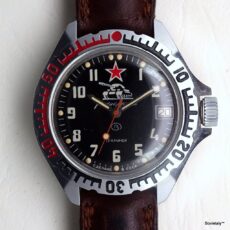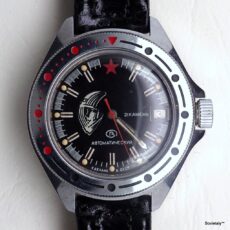In the world of Russian watches, the Poljot 2414 stands out as one of the most reliable and respected mechanical movements. What many collectors may not know is that its technical design closely follows Swiss movements made in Bienne, particularly the renowned FHF 96, which served as a technical benchmark for much of mid-20th-century European watchmaking.
Origins: Swiss Technology in the USSR
Following the establishment of its major watch factories, the Soviet watch industry often adapted Swiss designs to create efficient and easily serviceable movements. The Poljot 2414 is a prime example—a hand-wound movement with a small seconds sub-dial at 6 o’clock, engineered for long-term reliability and straightforward maintenance, just like its Swiss counterpart.
Technical Comparison: Poljot 2414 vs. FHF 96
The architectural similarities between the Poljot 2414 and the Swiss FHF 96 movement are striking:
- The bridges, wheel layout, and balance wheel placement are almost identical
- Both movements use a screw balance
- Component arrangement and finishing are very similar


The key differences are:
- Markings: The Poljot 2414 always features a clear reference and Soviet factory signature, while the Swiss FHF 96 is usually marked “Bienne” or “FHF.”
- Lubrication hole: The FHF 96 features a dedicated oiling hole on the balance bridge, allowing lubrication without disassembly. The 2414 lacks this feature, requiring the bridge to be removed for oiling.
- Finishing: The Swiss movement often boasts finer finishing, but the 2414 is celebrated for its legendary robustness and longevity.
A Common Practice in Soviet Watchmaking
The Poljot 2414 is not an isolated example; many other Soviet calibres were adapted from Swiss or French designs, including:
- Molnija (based on Cortebert 616)
- Pobeda (inspired by Lip R-26)
- Zarya, Chaika, Zvezda (adapted from Swiss or French ebauches)
Conclusion
The story of the Poljot 2414 and its Swiss reference movement demonstrates the Soviet factories’ ability to take the best of European watchmaking technology and adapt it for mass production. Today, the Poljot 2414 is recognized as one of the most reliable and enduring manual movements ever produced in Russia.
Acknowledgments
Special thanks to Aleksandr Brodnikovskiy for his YouTube video “Александр Бродниковский-Полет 2414 1МЧЗ и его швейцарский прототип,” which clearly explains the technical differences between these movements and offers an in-depth comparison for collectors and enthusiasts.



